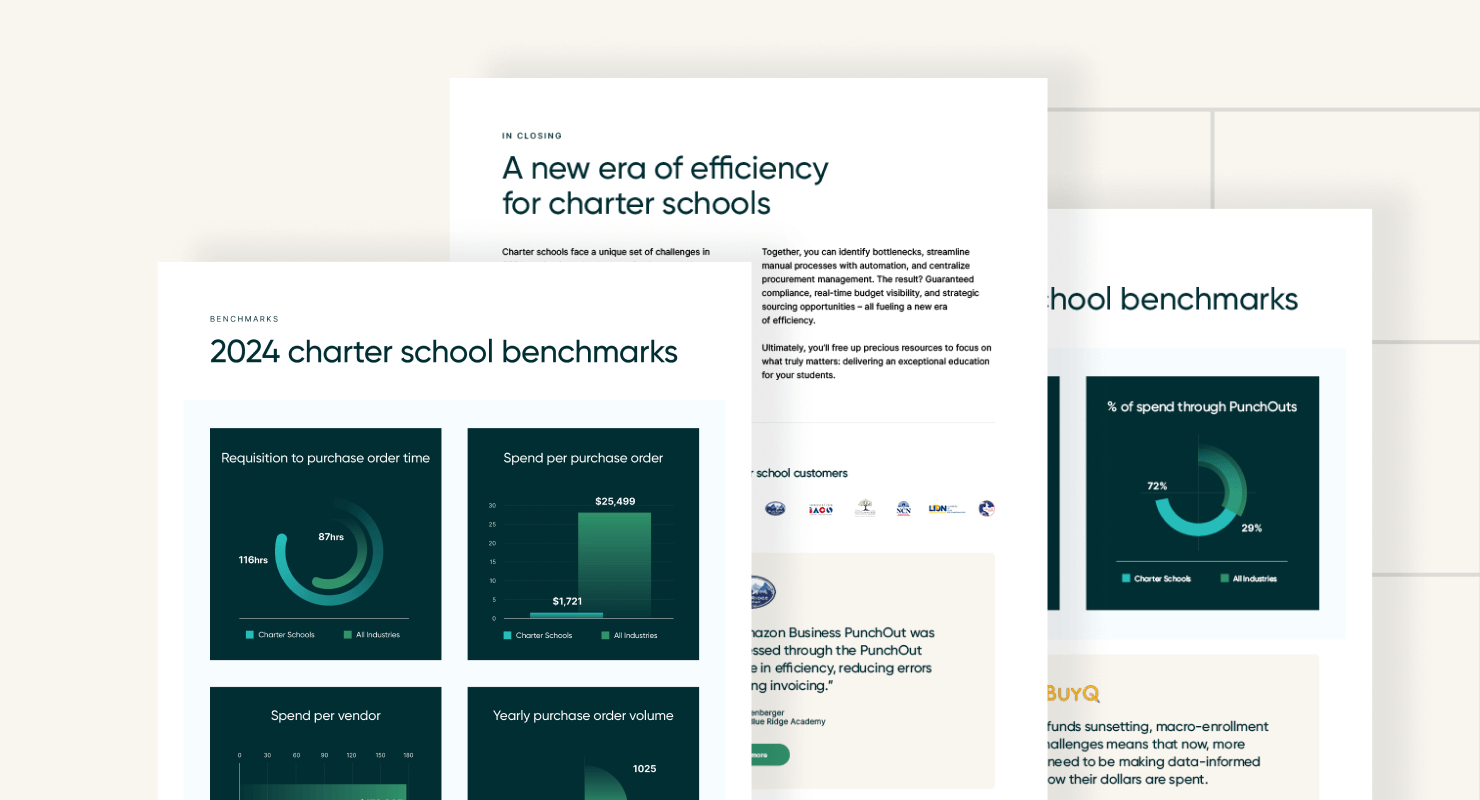
Spend Trends: 5 Financial Factors Shaping Charter Schools in 2024
Spend Trends is a Procurify editorial series that explores the current state of finance for a variety of industries through the lens of experts.
The popularity of charter schools in the United States is at a high.
That is, what is reported anyway in a 2023 study conducted by the National Alliance for Public Charter Schools. The study stated that charter school enrollment across the country has risen by over 40 percent – including growth in 40 states – since 2019.
But according to experts, the current overall financial health in the charter school sector might be trending in the other direction. Inflation and high interest rates are causing a rise in the cost of supplies and overhead. Enrollment is down in some states, which means that so is funding. In March 2020, the Elementary and Secondary School Emergency Relief Fund (ESSER) was created by the United States Government to offset the financial challenges created by the global financial crisis. The end of ESSER aid (which officially runs out on September 30, 2024) is causing widespread budget shortfalls for many institutions.
“Overall, we’re seeing a reduction in staffing,” said Jason Sitomer, Managing Director of Charter Impact, a company that assists charter schools with financial management and operational support and a partner of Procurify. Sitomer mentioned that some initial budgets for charter schools in 2024 were allocating up to 75 percent of their budgets to staffing, which is not sustainable and required adjustments to balance their budget.
“That’s just not a place of sustainability,” he added. “Schools – both charter and traditional public – are finding themselves in a difficult position and needing to contemplate cutting 10 percent or more of their staff in many situations.”
For many states, the start of summer signals a crucial period in a charter school’s fiscal calendar. The state budgets are proposed, negotiated between the legislative bodies and the governors, and submitted in late June, sometimes even stretching into July before the state’s budget is approved. This leaves lots of uncertainty for charter schools that have to have their budgets approved in June.
“Throughout the spring and toward the end of the school year, charter schools are busy making a lot of budgetary changes. There’s also a lot of year-end compliance items to complete in June,” Sitomer said. “So, schools need to be both forward-looking and backwards-looking all at the same time to wrap their year and enter the next on a good foot.”
This year’s fiscal planning for charter schools promises to be especially challenging, particularly, around spending and budgets (or lack thereof). We dug deeper to understand and analyze 5 spending trends that may influence these urgent decisions in the coming year.
1. Resourcefulness is the name of the game
Like many other industries nowadays, the message to charter schools is clear: do more with less. Nationwide budget cuts in education have meant large deficits, teacher layoffs, lower spend per student, and in some instances, closures in the charter schools sector. The end of COVID-relief and ESSER aid has also impacted charter school balance sheets.
“This is the first year that we’re seeing our clients’ budgets shrinking,” said Sitomer. “In the past, there was enough one-time funding from ESSER to bridge the gap or fill in the shortcomings from things like declining enrollment.” As a result, he added, “Some [charter schools] are going to need to find 15-plus percent of their budgets to cut because this one-time funding that everyone relied on during the COVID-era is no longer there.”
Charter schools in particular are at a fiscal disadvantage. A 2023 study by the University of Arkansas found that on average, charter schools received only 70 percent of the funding that traditional public schools receive.
But the limited funding has not limited the performance of its students – in fact, quite the opposite. The most recent (2023) study by The Center for Research on Education Outcomes (CREDO) at Stanford University discovered that charter school students, on average, outperformed traditional public school students academically.
Being resourceful with their spending and cognizant of any wasteful allocation of funds is the key to long-term sustainability. In recent years, it seems that collectively, the charter school space has been able to do a better job stretching the ROI of its funding.
2. Teacher shortage will impact budgets
Over a dozen states –including California, Nevada, and New Mexico – are currently facing significant teacher shortages. Last year, there were over 55,000 public school teacher vacancies in the U.S.
“Districts, charter schools, and counties – they’re all competing for the same pool of candidates,” said Sitomer, who added that the teacher shortage coupled with surging cost of living have resulted in charter schools increasing salaries to attract talent. “So, you’re seeing some schools putting themselves in a detrimental position financially,” he said.
Without past federal grants and a multitude of current economic factors, being strategic and intentional with every dollar being spent will be critical for short and long-term viability. Retaining strong financial leadership and responsibly cutting costs in non-teacher overhead (supplies, support staff, etc.) will help stop the bleeding.

3. Strength in numbers: Charter schools are consolidating
Smaller schools with low enrollment managed to stay afloat during the pandemic due to increased short-term funding. Now that those dollars are no longer available, it has become difficult for many charter schools with less than 200 students to balance their budgets.
Consolidating smaller schools (sometimes three schools into one) has become a popular solution to combat declining enrollment and increasing operating costs.
“The model of schools tends to work the best when you have over 200 students,” said Sitomer, who is based in California. “There’s an economy of scale that kicks in and as a result, we’re seeing more partnerships, mergers, consolidations, and closures.”
4. Save money. Except ESSER
As previously mentioned, the one-time ESSER funding ends on September 30th of this year. ESSER funds, to the tune of $190 billion, were created in response to extreme funding challenges for public elementary schools in the post-pandemic economy. While the discontinuation of the fund will encourage saving and strategic spending going forward, schools are strongly encouraged to quickly spend their current remaining ESSER funds.
“We’ve advised all of our charter school clients to spend whatever ESSER money is left before June 30,” he said. “We don’t want them to risk the possibility of not spending the entirety of their funding. That could still make a difference in their upcoming budgets.”
For some charter schools, according to Sitomer, ESSER funding accounted for up to 10 percent of their annual budget.
5. AI is not driving decisions…yet
AI is writing our corporate reports. It is aggregating our data. It is making data-driven business decisions. There are many industries where AI is automating the workflow and in the process improving efficiency and saving on labor costs. However, many charter schools are not using AI effectively…. yet.
“As of now, AI isn’t being routinely leveraged in charter schools,” said Sitomer, adding there might be opportunities to use AI to address staffing, administrative, and reporting tasks. “AI might make things easier or help reduce costs, but I don’t think it’s quite there yet. I think we’ll see more adoption in the coming years.”
In the education sector – particularly in universities – AI is being used in enrollment tasks (i.e. submitting forms) and communication (i.e. automated correspondence with students and parents). In the charter school space, Sitomer foresees AI contributing to the reporting, documentation and satisfying increasingly stringent compliance processes. He also estimates that AI will be used to assist staff and teachers – not replace them.
“That simple automation eliminates the human labor element away and allows staff to repurpose those hours into somewhere else,” said Sitomer. “It still requires a human person physically there.”
And the role of humans will be especially important during this challenging time for charter schools. While the prospects of stronger economic times and new sources of funding are unclear, charter school financial leaders must be cognizant of these trends and vigilant with the spending. Better times are ahead, charter schools just need to strategically weather the storm in the meantime.

2025 Procurement Benchmark Report
Powered by $20B+ in proprietary data you won’t find anywhere else.



